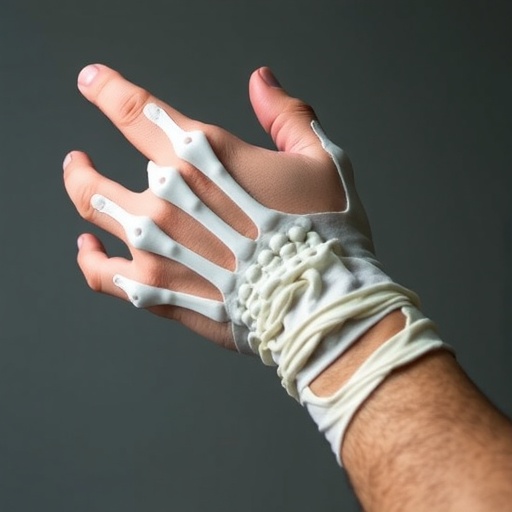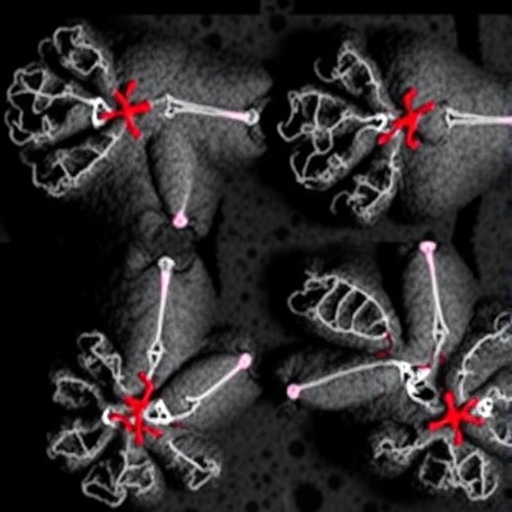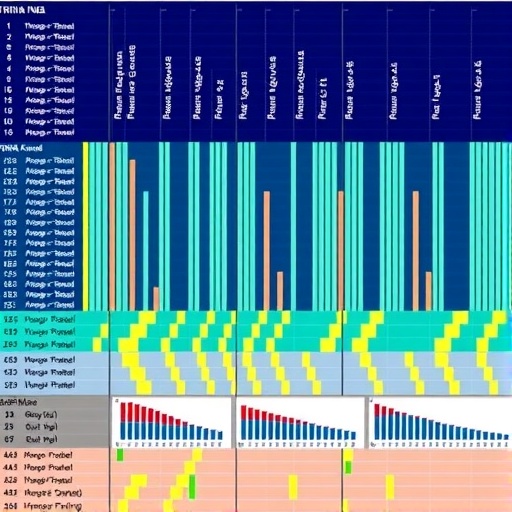
In a groundbreaking forensic case that underscores the hidden dangers of orthopedic immobilization, researchers have revealed a fatal incident of necrotizing fasciitis developing under a plaster cast applied to an upper extremity. This alarming case report not only illustrates the rapid and devastating progression of soft tissue infections but also highlights essential considerations for clinical practice and post-mortem examination. The detailed forensic autopsy sheds light on a complex interplay between immobilization, bacterial invasion, and tissue necrosis, raising awareness about a life-threatening complication that, while rare, demands urgent medical attention.
Necrotizing fasciitis, often dubbed the “flesh-eating disease,” is a rapidly progressing soft tissue infection characterized by widespread fascial necrosis and systemic toxicity. In the presented case, a plaster cast, widely used for immobilizing fractures or soft tissue injuries, became a silent incubator for bacterial proliferation and subsequent tissue destruction. The report meticulously details how the confined, occlusive environment created by the plaster cast contributed to an anaerobic milieu favoring pathogenic growth and exacerbation of the infectious process. This scenario challenges traditional notions of cast safety and compels healthcare providers to maintain high vigilance in monitoring casted limbs for early signs of infection.
The forensic autopsy findings unveiled extensive soft tissue necrosis beneath the plaster, extending deep into the fascial planes and muscle compartments of the upper extremity. Microscopic examinations confirmed widespread coagulative necrosis, severe inflammatory infiltrates, and microvascular thrombi, hallmark features of necrotizing fasciitis. Remarkably, the cutaneous surface revealed only subtle evidence of infection, illustrating how external inspection may underestimate the severity of underlying pathology. These observations resonate profoundly with forensic pathologists endeavoring to discern cause of death in challenging contexts involving concealed infections.
.adsslot_4BYQi9HX6s{width:728px !important;height:90px !important;}
@media(max-width:1199px){ .adsslot_4BYQi9HX6s{width:468px !important;height:60px !important;}
}
@media(max-width:767px){ .adsslot_4BYQi9HX6s{width:320px !important;height:50px !important;}
}
ADVERTISEMENT
From a microbiological standpoint, the analysis identified a polymicrobial infection predominated by virulent strains of Group A Streptococcus and anaerobic bacteria. The synergistic interaction between these pathogens amplifies tissue destruction through the release of exotoxins and enzymes such as hyaluronidase and streptolysins. These enzymatic activities facilitate rapid dissemination of necrosis, vascular occlusion, and profound systemic inflammatory response syndrome (SIRS), rapidly leading to multiorgan failure and death. This case reinforces the necessity for early microbiological sampling and broad-spectrum antimicrobial coverage when necrotizing fasciitis is suspected clinically.
The pathophysiological mechanisms underlying the evolution of necrotizing fasciitis in an immobilized limb raise critical questions regarding the balance between immobilization benefits and potential risks. Immobilization reduces vascular perfusion and lymphatic drainage, creating a vulnerable microenvironment allowing bacterial colonization and impaired immune surveillance. Additionally, microtraumas beneath the cast due to pressure or friction may facilitate bacterial entry. This intricate pathogenesis underscores the importance of meticulous patient assessment and frequent surveillance following cast application, particularly in high-risk cohorts such as diabetics or immunocompromised patients.
From a medico-legal perspective, the case epitomizes the complex diagnostic challenge posed by concealed infections. The forensic investigation meticulously excluded alternative causes of death, integrating macroscopic, microscopic, and microbiological data to confirm necrotizing fasciitis as the primary lethal event. The report advocates for comprehensive protocols in forensic autopsy when encountering sudden, unexpected deaths involving previously immobilized limbs, emphasizing interdisciplinary collaboration between forensic experts, clinicians, and microbiologists to establish accurate cause-of-death determinations.
Clinicians, orthopedic surgeons, and emergency care providers stand to gain critical insights from this case, as early recognition of necrotizing fasciitis remains paramount to improving patient outcomes. The subtle clinical clues such as disproportionate pain, rapid swelling, systemic toxicity, and compromised distal circulation require immediate diagnostic workup, including imaging modalities like MRI and prompt surgical consultation. Furthermore, the case illustrates that even in the absence of overt skin ulceration or trauma, necrotizing fasciitis can silently progress beneath immobilization devices, rendering traditional diagnostic heuristics insufficient.
The evolving trend of outpatient fracture management and cast application amplifies the public health implications of such infections. Patient education regarding cast care, recognition of warning signs, and timely access to healthcare resources are essential components in mitigating the risk of devastating complications. The reported forensic autopsy serves as a cautionary tale to health systems worldwide, emphasizing that immobilization protocols must be complemented by robust patient monitoring frameworks and swift intervention pathways.
Technological advances in cast materials and design may also play a role in preventing similar occurrences. Breathable, antimicrobial-impregnated casting materials or removable splints could allow better skin inspection and reduced bacterial colonization. This case report invigorates the call for research into innovative orthopedic immobilization strategies that balance fracture stabilization with infection prevention, potentially reshaping standard care practices in traumatology.
The systemic impact of necrotizing fasciitis culminating in mortality elucidated in this report aligns with the broader understanding of sepsis pathogenesis. Once the infection breaches local control, systemic inflammatory mediators trigger a cascade of cellular dysfunction, endothelial damage, and coagulopathy. Multiorgan failure ensues swiftly if untreated, as observed in this case where post-mortem examination revealed organ congestion and ischemic changes. This outcome underscores the critical window for intervention and the dire consequences of diagnostic delay.
Interestingly, the presented case raises important ethical and legal questions regarding informed consent and risk communication prior to cast application. While immobilization is a routine and lifesaving intervention, patients must be adequately informed about potential, albeit rare, complications such as life-threatening infections. This ethical dimension enriches the discourse on shared decision-making and reinforces the clinician’s responsibility to ensure vigilance in post-treatment follow-up.
Additionally, the forensic narrative in this report serves as a reminder of the pivotal role of pathology in bridging clinical and legal domains. Through detailed morphological assessments, forensic pathologists can reveal silent killers such as necrotizing fasciitis that might elude clinical detection. This reinforces the multidisciplinary nature of medical investigations that not only elucidate cause of death but also contribute to quality improvement in clinical practices.
The case report also invites reflection on the global burden of necrotizing fasciitis, its epidemiology, and public health strategies. Incidence varies geographically but remains a challenging entity with high mortality rates. Identifying preventable risk factors, promoting early clinical suspicion, and ensuring resource availability for prompt surgical intervention are essential components in curbing fatalities. This case situates itself prominently in this continuum by illustrating a preventable death scenario linked to routine medical care.
Finally, the detailed forensic autopsy and clinical correlation in this report enrich the medical literature by emphasizing a rare yet fatal complication in orthopedic care. It serves as a rallying call to clinicians, researchers, and public health authorities to devise integrated approaches combining careful clinical management, patient education, and innovative technologies to eradicate such avoidable tragedies. Awareness campaigns and continued research into the pathogenesis and early detection markers of necrotizing fasciitis will be crucial in changing the narrative surrounding immobilization-associated infections.
Subject of Research: Necrotizing fasciitis occurring beneath a plaster cast in an upper extremity leading to fatality, investigated through forensic autopsy.
Article Title: Necrotizing fasciitis in a plaster casted upper extremity: a forensic autopsy case report.
Article References:
Alghaithi, A., Epain, M., Advenier, As. et al. Necrotizing fasciitis in a plaster casted upper extremity: a forensic autopsy case report. Int J Legal Med (2025). https://doi.org/10.1007/s00414-025-03548-5
Image Credits: AI Generated
Tags: bacterial growth under castsclinical implications of necrotizing fasciitisfatal complications of orthopedic immobilizationflesh-eating disease case reportforensic autopsy findings in infectionshidden dangers of plaster castsmonitoring for infection in immobilized limbsnecrotizing fasciitis incidence in plaster castsorthopedic care and infection preventionsoft tissue infection progressiontissue necrosis and cast safetyurgent medical attention for necrotizing fasciitis





